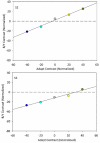Adjusting to a sudden “aging” of the lens
- PMID: 26924924
- PMCID: PMC4765957
- DOI: 10.1364/JOSAA.33.00A129
Adjusting to a sudden “aging” of the lens
Abstract
Color perception is known to remain largely stable across the lifespan despite the pronounced changes in sensitivity from factors such as the progressive brunescence of the lens. However, the mechanisms and timescales controlling these compensatory adjustments are still poorly understood. In a series of experiments, we tracked adaptation in observers after introducing a sudden change in lens density by having observers wear glasses with yellow filters that approximated the average spectral transmittance of a 70-year-old lens. Individuals were young adults and wore the glasses for 5 days for 8 h per day while engaged in their normal activities. Achromatic settings were measured on a CRT before and after each daily exposure with the lenses on and off, and were preceded by 5 min of dark adaptation to control for short-term chromatic adaptation. During each day, there was a large shift in the white settings consistent with a partial compensation for the added lens density. However, there was little to no evidence of an afterimage at the end of each daily session, and participants’ perceptual nulls were roughly aligned with the nulls for short-term chromatic adaptation, suggesting a rapid renormalization when the lenses were removed. The long-term drift was also extinguished by brief exposure to a white adapting field. The results point to distinct timescales and potentially distinct mechanisms compensating for changes in the chromatic sensitivity of the observer.
Figures









References
-
- Pokorny J, Smith VC, Lutze M. Aging of the human lens. Applied optics. 1987;26:1437. - PubMed
-
- Werner JS, Schefrin BE, Bradley A. Optics and vision of the aging eye. Handbook of optics. 2000;30:20.
-
- Lindsey DT, Brown AM. Color naming and the phototoxic effects of sunlight on the eye. Psychological science. 2002;13:506–512. - PubMed
-
- Kraft JM, Werner JS. Aging and the saturation of colors. 1. Colorimetric purity discrimination. Journal of the Optical Society of America. A, Optics, image science, and vision. 1999;16:223–230. - PubMed
Publication types
MeSH terms
Substances
Grants and funding
LinkOut - more resources
Full Text Sources
Other Literature Sources
Medical
Research Materials

